Abstract
Awareness of the adverse ecological effects of road and other large construction projects has resulted in a rapidly growing demand to quantitatively predict and evaluate the effects on gene flow among plants and animals in natural habitats. In this study, we evaluated the effects of different road construction scenarios on animal species movement by using the methods of ecological landscape connectivity in the typical regions of Yunnan Province, China. The results showed landscape connectivity levels (Probability of Connectivity (PC)) decreased after road construction and species with lower dispersal abilities were more affected to the subsequent habitat fragmentation. First level roads affected landscape connectivity most significantly. At a distance of 100 m, the PC index decreased more than 50%. Further analysis suggested that the use of landscape connectivity to assess landscape processes revealed the adverse effects on the species movement more effectively compared with the traditional landscape pattern analysis. In addition, we conducted a graph theory and a least-cost modeling discussion, it is obvious that they are powerful tools to represent and analyze landscape networks with respect to related species movement. Network analysis offers a quantitative and simple but effective tool for ecological process assessment and biological conservation on large scales.
Similar content being viewed by others
References
Adriaensen F, Chardon J P, De Blust G et al., 2003. The application of’ least-cost’ modelling as a functional landscape model. Landscape and Urban Planning, 64(4): 233–247. doi: 10.1016/S0169-2046(02)00242-6
Baguette M, van Dyck H, 2007. Landscape connectivity and animal behavior: Functional grain as a key determinant for dispersal. Landscape Ecology, 22: 1117–1129. doi: 10.1007/s10980-007-9108-4
Baudry J, Burel F, Aviron S et al., 2003. Temporal variability of connectivity in agricultural landscapes: Do farming activities help? Landscape Ecology, 18(3): 303–314. doi: 10.1023/A:1024465200284
Bunn A G, Urban D L, Keitt T H, 2000. Landscape connectivity: A conservation application of graph theory. Journal of Environmental Management, 59(4): 265–278. doi: 10.1006/jema.2000.0373
Chen Lingding, Lyu Yihe, Tian Huiying et al., 2007. Principles and methodology for ecological rehabilitation and security pattern design in key project construction. Chinese Journal of Applied Ecology, 18: 674–680. (in Chinese)
Crist M R, Wilmer B, Aplet G H, 2005. Assessing the value of roadless areas in a conservation reserve strategy: Biodiversity and landscape connectivity in the northern Rockies. Journal of Applied Ecology, 42(1): 181–191. doi: 10.1111/j.1365-2664.2005.00996.x
Erős T, Schmera D, Schick R S, 2011. Network thinking in riverscape conservation—A graph-based approach. Biological Conservation, 144(1): 184–192. doi: 10.1016/j.biocon.2010.08. 013
Foley J A, Defries R, Asner G P et al., 2005. Global consequences of land use. Science, 309(5734): 570–574. doi: 10.1126/science.1111772
Foltête J C, Berthier K, Cosson J F, 2008. Cost distance defined by a topological function of landscape. Ecological Modelling, 210(1–2): 104–114. doi: 10.1016/j.ecolmodel.2007.07.014
Foltête J C, Clauzel C, Vuidel G, 2012. A software tool dedicated to the modelling of landscape networks. Environmental Modelling & Software, 38: 316–327. doi: 10.1016/j.envsoft.2012.07.002
Foltête J C, Giraudoux P, 2012. A graph-based approach to investigating the influence of the landscape on population spread processes. Ecological Indicators, 18: 684–692. doi: 10.1016/j.ecolind.2012.01.011
Forman R T T, 1998. Roads and their major ecological effects. Annual Review of Ecology and Systematics, 29: 207–231. doi: 10.1146/annurev.ecolsys.29.1.207
Frair J L, Merrill E H, Beyer H L et al., 2008. Thresholds in landscape connectivity and mortality risks in response to growing road networks. Journal of Applied Ecology, 45(5): 1504–1513. doi: 10.1111/j.1365-2664.2008.01526.x
Fu Wei, Liu Shiliang, Degloria S D et al., 2010. Characterizing the “fragmentation-barrier” effect of road networks on landscape connectivity: A case study in Xishuangbanna, Southwest China. Landscape and Urban Planning, 95(3): 122–129. doi: 10.1016/j.landurbplan.2009.12.009
Galpern P, Manseau M, Fall A, 2011. Patch-based graphs of landscape connectivity: A guide to construction, analysis and application for conservation. Biological Conservation, 144(1): 44–55. doi: 10.1016/j.biocon.2010.09.002
Gurrutxaga M, Lozano P J, del Barrio G, 2010. GIS-based approach for incorporating the connectivity of ecological networks into regional planning. Journal for Nature Conservation, 18(4): 318–326. doi: 10.1016/j.jnc.2010.01.005
Hawbaker T J, Radeloff V C, Hammer R B et al., 2005. Road density and landscape pattern in relation to housing density, and ownership, land cover, and soils. Landscape Ecology, 20: 609–625. doi: 10.1007/s10980-004-5647-0
Li T, Shilling F, Thorne J et al., 2010. Fragmentation of China’s landscape by roads and urban areas. Landscape Ecology, 25: 839–853. doi: 10.1007/s10980-010-9461-6
Liu S L, Cui B S, Dong S K et al., 2008. Evaluating the influence of road networks on landscape and regional ecological risk—A case study in Lancang River Valley of Southwest China. Ecological Engineering, 34(2): 91–99. doi: 10.1016/j.ecoleng.2008.07.006
McGarigal K, Cushman S A, Ene E, 2012. FRAGSTATS v4: Spatial Pattern Analysis Program for Categorical and Continuous Maps. Computer software program produced by the authors at the University of Massachusetts, Amherst. Available at: http://www.umass.edu/landeco/research/fragstats/fragstats.html
McRae B H, 2006. Isolation by resistance. Evolution, 60(8): 1551–1561. doi: 10.1111/j.0014-3820.2006.tb00500.x
Minor E S, Urban D L, 2007. Graph theory as a proxy for spatially explicit population models in conservation planning. Ecological Applications, 17(6): 1771–1782. doi: 10.1890/06-1073.1
Minor E S, Urban D L, 2008. A graph-theory framework for evaluating landscape connectivity and conservation planning. Conservation Biology, 22(2): 297–307. doi: 10.1111/j.1523-1739.2007.00871.x
Pascual-Hortal L, Saura S, 2006. Comparison and development of new graph-based landscape connectivity indices: Towards the priorization of habitat patches and corridors for conservation. Landscape Ecology, 21(7): 959–967. doi: 10.1007/s10980-006-0013-z
Pascual-Hortal L, Saura S, 2007. Impact of spatial scale on the identification of critical habitat patches for the maintenance of landscape connectivity. Landscape and Urban Planning, 83(2–3): 176–186. doi: 10.1016/j.landurbplan.2007.04.003
Reza M I H, Abdullah S A, 2011. Regional Index of Ecological Integrity: A need for sustainable management of natural resources. Ecological Indicators, 11: 220–229. doi: 10.1016/j.ecolind.2010.08.010
Saura S, Estreguil C, Mouton C et al., 2011. Network analysis to assess landscape connectivity trends: Application to European forests (1990–2000). Ecological Indicators, 11(2): 407–416. doi: 10.1016/j.ecolind.2010.06.011
Saura S, Pascual-Hortal L, 2007. A new habitat availability index to integrate connectivity in landscape conservation planning: Comparison with existing indices and application to a case study. Landscape and Urban Planning, 83(2–3): 91–103. doi: 10.1016/j.landurbplan.2007.03.005
Saura S, Torné J, 2009. Conefor Sensinode 2.2: A software package for quantifying the importance of habitat patches for landscape connectivity. Environmental Modelling & Software, 24(1): 135–139. doi: 10.1016/j.envsoft.2008.05.005
Taylor P D, Fahrig L, Henein K et al., 1993. Connectivity is a vital element of landscape structure. Oikos, 68(3): 571–573. doi: 10.2307/3544927
Urban D L, Keitt T H, 2001. Landscape connectivity: A graph-theoretic perspective. Ecology, 82(5): 1205–1218. doi: 10.1890/0012-9658(2001)082[1205:LCAGTP]2.0.CO;2
Urban D L, Minor E S, Treml E A et al., 2009. Graph models of habitat mosaics. Ecology Letters, 12(3): 260–273. doi: 10.1111/j.1461-0248.2008.01271.x
With K A, Crist T O, 1995. Critical thresholds in species’ responses to landscape structure. Ecology, 76(8): 2446–2459. doi: 10.2307/2265819
Yue D, Xu X, Li Z et al., 2006. Spatiotemporal analysis of ecological footprint and biological capacity of Gansu, China 1991–2015: Down from the environmental cliff. Ecological Economics, 58(2): 393–406. doi: 10.1016/j.ecolecon.2005.07.029
Zetterberg A, Mörtberg U M, Balfors B, 2010. Making graph theory operational for landscape ecological assessments, planning, and design. Landscape and Urban Planning, 95(4): 181–191. doi: 10.1016/j.landurbplan.2010.01.002
Author information
Authors and Affiliations
Corresponding author
Additional information
Foundation item: Under the auspices of Nonprofit Environment Protection Specific Project of China (No. 201209029-4)
Rights and permissions
About this article
Cite this article
Liu, S., Deng, L., Chen, L. et al. Landscape network approach to assess ecological impacts of road projects on biological conservation. Chin. Geogr. Sci. 24, 5–14 (2014). https://doi.org/10.1007/s11769-014-0651-z
Published:
Issue Date:
DOI: https://doi.org/10.1007/s11769-014-0651-z




